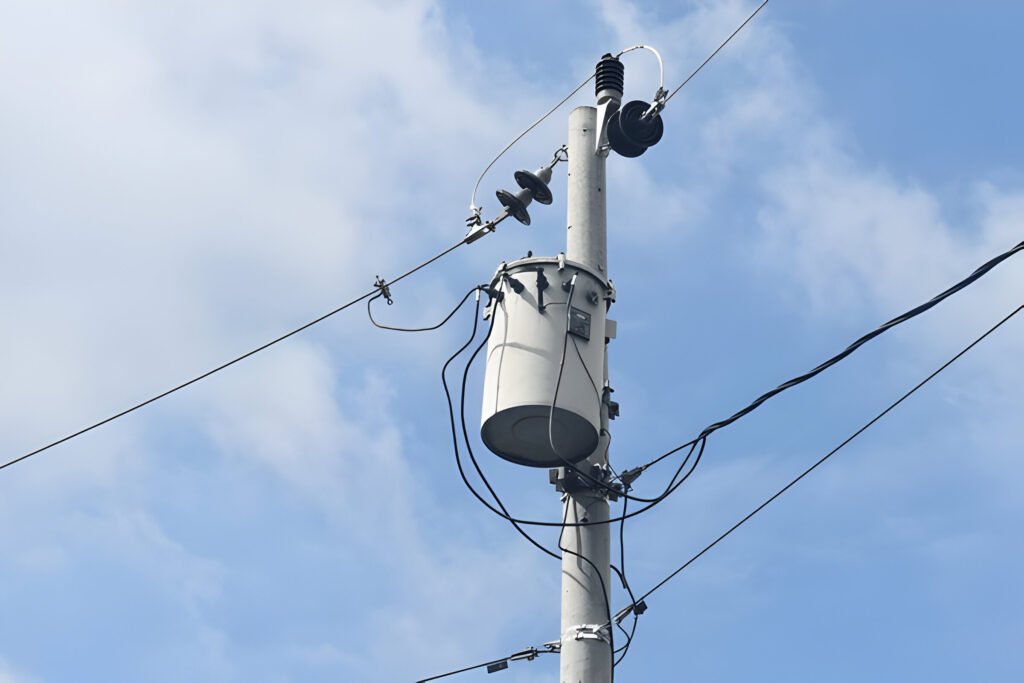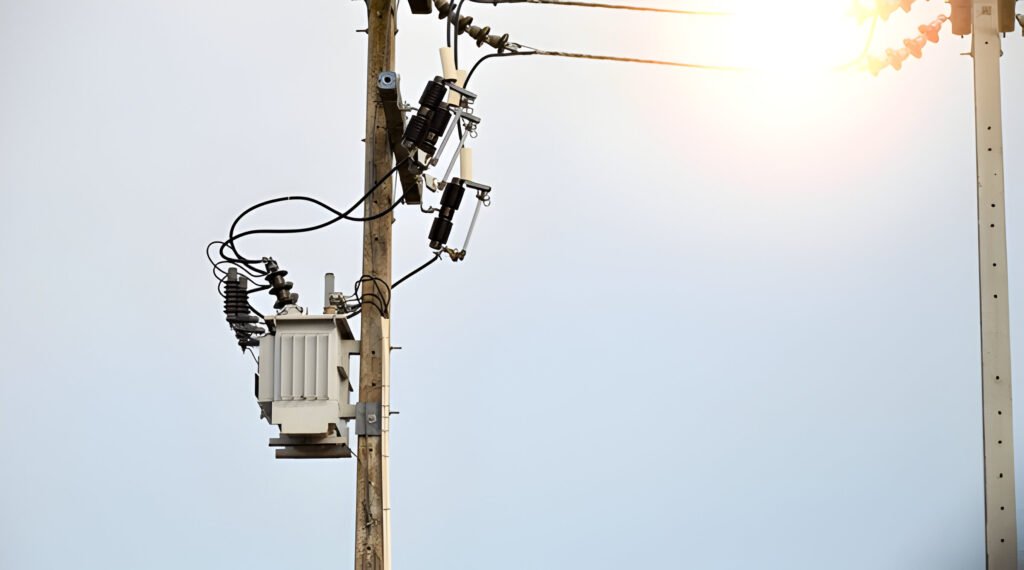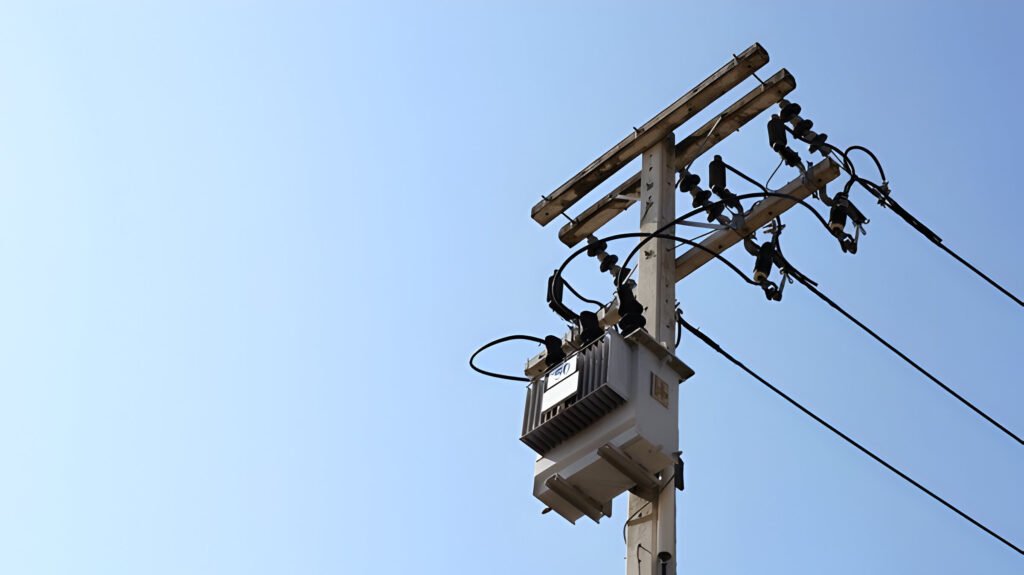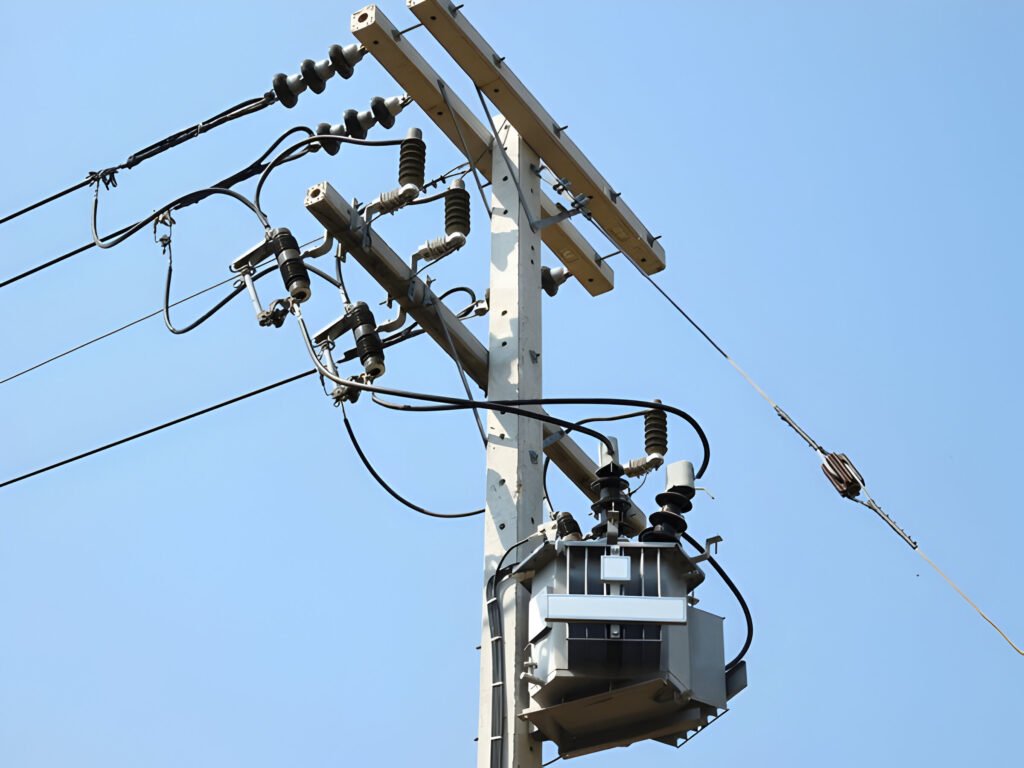How to Fix Transformer Oil Leakage
Learn effective techniques to identify, repair and prevent transformer oil leakage issues.
Read More

A pole-mounted transformer is an essential component of electrical power distribution systems, typically used to step down high voltage electricity for residential and commercial use. These transformers are mounted on utility poles, hence their name.
Pole-mounted transformers are designed to reduce the voltage from primary distribution levels (usually between 4 kV and 34.5 kV) to secondary distribution levels (commonly 120/240 V for single-phase residential service or 208Y/120 V and 480Y/277 V for three-phase commercial applications).
At their core, pole-mounted transformers operate through electromagnetic induction. The transformer’s primary winding connects to the high-voltage line, while the secondary winding links to the lower-voltage service drop that runs to buildings. As alternating current (AC) flows through the primary winding, it generates a fluctuating magnetic field within the transformer’s iron core. This magnetic field then induces a current in the secondary winding, effectively transferring energy between the windings.
The voltage transformation is determined by the ratio of turns in the primary and secondary windings. For instance, if the primary winding has 100 turns and the secondary winding has 10 turns, the output voltage will be one-tenth of the input voltage.

At the heart of the transformer is the iron core. This component provides a path for magnetic flux, facilitating the efficient transfer of energy between the primary and secondary windings. The iron core’s design minimizes energy losses, making the transformer highly efficient.
The primary winding consists of high voltage insulated wire. This winding receives electricity from the main power lines and is engineered to handle high voltage input. Typically, the primary winding is thinner and has more turns, allowing it to manage the higher voltage effectively.
The secondary winding is made of low voltage insulated wire. This winding delivers the stepped-down voltage to the distribution network. It is usually thicker with fewer turns to accommodate a higher current output, ensuring reliable delivery of electricity to homes and businesses.
Insulating oil surrounds the iron core and windings, serving multiple critical functions. It acts as a coolant, dissipating the heat generated during operation. Additionally, the oil provides electrical insulation, preventing arcing between components. It also protects internal parts from moisture and contaminants, ensuring the longevity and reliability of the transformer.
These components are enclosed in a sealed tank, often equipped with radiator fins to enhance heat dissipation. The tank is securely mounted on a pole using specialized brackets, positioning the transformer at a safe height for both operation and maintenance.

You’ll find two main types of pole-mounted transformers: conventional transformers and Completely Self-Protected (CSP) transformers. Conventional transformers are the more basic type, typically used in rural areas or where reliability isn’t a critical concern. CSP transformers, on the other hand, offer enhanced protection features and are often preferred in urban or high-demand settings.
Conventional transformers are a critical component in electrical distribution systems, primarily used to step down high voltage from primary distribution lines to the lower voltages required for residential and commercial applications.
Typically mounted on utility poles, these transformers are secured using brackets or crossarms. They are encased in metal tanks filled with mineral oil, which acts as both an insulator and coolant. The core and windings are submerged in this oil, ensuring efficient heat dissipation and providing protection against environmental factors.
Conventional transformers are available in various sizes, ranging from 5 kVA to 167 kVA, depending on the load demands of the area they serve. They are equipped with bushings on the top or side of the tank for connecting to primary and secondary lines.
Known for their reliability and long service life, conventional transformers are designed to endure harsh weather conditions and electrical surges. However, their weight can pose challenges in installation and maintenance.
A Completely Self-Protected (CSP) transformer is an advanced pole-mounted transformer featuring built-in protective mechanisms designed to safeguard both the transformer and the electrical system from faults and overloads. Key protective components include internal fuses, lightning arresters, and thermal protection devices.
One of the pivotal features of CSP transformers is the automatic circuit recloser. This device detects faults and temporarily disconnects the transformer from the power line. If the fault is cleared, the recloser automatically reconnects the transformer, minimizing power outages and reducing the need for manual intervention.
CSP transformers are equipped with overload protection to prevent damage from excessive current. These transformers are more compact compared to conventional models, as all protective components are housed within the transformer tank.

The elevated positioning of pole-mounted transformers on utility poles provides enhanced protection against flooding and vandalism, and reduces the risk of accidents involving pedestrians or vehicles.
By utilizing existing utility poles, there is no need for additional ground space for transformer installations. This is particularly advantageous in urban areas where land availability is limited.
They are generally less expensive to install and maintain compared to pad-mounted or underground alternatives. Their elevated position facilitates easier access for utility workers during maintenance and repair activities.
The exposed position allows for natural air circulation, which aids in dissipating heat more efficiently. This can enhance the performance and extend the lifespan of the transformer.
Pole-mounted transformers can be easily relocated or replaced if necessary, providing flexibility in the design and maintenance of electrical distribution systems.
Pole-mounted transformers are more susceptible to environmental factors, such as severe weather conditions, lightning strikes, and wildlife interference. This heightened exposure can lead to increased maintenance costs and potential power outages, impacting both utility providers and consumers.
Generally smaller than pad-mounted or vault-mounted transformers, pole-mounted transformers have a restricted ability to handle high power loads. This limitation can become problematic in areas experiencing growing energy demands, necessitating the implementation of additional transformers to meet the increased load.
Positioned at considerable heights, pole-mounted transformers pose challenges for maintenance and repair activities, increasing the risk for utility workers. Additionally, their elevated placement can endanger the public during extreme weather events or accidents involving utility poles, potentially leading to hazardous situations.
Pole-mounted transformers can be perceived as eyesores in residential areas. Their prominent visibility may detract from the overall appearance of neighborhoods, potentially affecting property values and leading to community resistance against new installations.
Due to their exposure to environmental elements, pole-mounted transformers tend to have a shorter lifespan compared to their ground-level counterparts. This necessitates more frequent replacements, thereby increasing long-term costs for utility companies.
These transformers typically range from 5 kVA to 167 kVA in capacity, with standard voltage ratings of 7.2 kV, 14.4 kV, or 19.9 kV on the primary side. The secondary voltage is usually 120/240V for single-phase transformers or 208Y/120V for three-phase units.
Pole-mounted transformers have a Basic Impulse Level (BIL) rating, indicating their ability to withstand voltage surges. Common BIL ratings are 60 kV, 75 kV, or 95 kV. These transformers are designed to operate in ambient temperatures ranging from -40°C to 40°C.

Electric utilities depend significantly on pole-mounted transformers for a wide array of applications in power distribution systems. These transformers are predominantly utilized in residential and rural areas to step down high-voltage electricity from primary distribution lines to lower, usable levels for homes and small businesses.
In urban settings, pole-mounted transformers distribute power to multiple customers, including several buildings or apartment complexes. They also provide electricity to municipal infrastructure such as street lighting and traffic signals.
In rural regions, these transformers supply power to farms, isolated homes, and small industrial facilities.
Pole-mounted transformers are frequently used in temporary power installations at construction sites or events due to their portability and ease of installation. Utility companies also deploy them for emergency power restoration following natural disasters or outages.
Pole-mounted transformers usually need maintenance every 3-5 years. They are designed to last 20-30 years with proper care.
Yes, pole-mounted transformers are used in residential areas to step down high-voltage power from distribution lines to a lower voltage suitable for homes.
Pole-mounted transformers generally last 20-30 years. Proper care may extend service beyond 40 years.
Pole-mounted transformers are affected by extreme weather like high winds, lightning, ice storms, and flooding. These conditions can damage components, disrupt power supply, and shorten the transformer’s lifespan.
The cost to install a pole-mounted transformer typically ranges from $3,000 to $7,000. Prices vary based on the transformer’s size, location, and local labor rates. Permit fees may also apply.
Yes, pole mounted transformers are generally safe when properly installed and maintained.